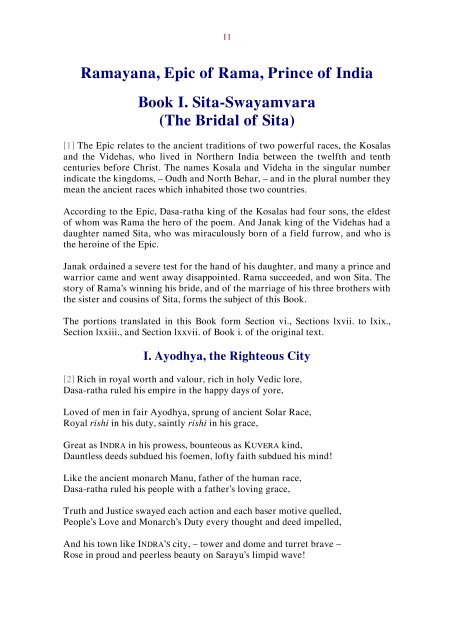Ramayana, Epic of Rama, Prince of India
An Abbreviated Translation of the Indian Classic, the Ramayana by Romesh Chundar Dutt in 2,000 verses
An Abbreviated Translation of the Indian Classic, the Ramayana by Romesh Chundar Dutt in 2,000 verses
Create successful ePaper yourself
Turn your PDF publications into a flip-book with our unique Google optimized e-Paper software.
11<br />
<strong><strong>Rama</strong>yana</strong>, <strong>Epic</strong> <strong>of</strong> <strong>Rama</strong>, <strong>Prince</strong> <strong>of</strong> <strong>India</strong><br />
Book I. Sita-Swayamvara<br />
(The Bridal <strong>of</strong> Sita)<br />
[1] The <strong>Epic</strong> relates to the ancient traditions <strong>of</strong> two powerful races, the Kosalas<br />
and the Videhas, who lived in Northern <strong>India</strong> between the twelfth and tenth<br />
centuries before Christ. The names Kosala and Videha in the singular number<br />
indicate the kingdoms, – Oudh and North Behar, – and in the plural number they<br />
mean the ancient races which inhabited those two countries.<br />
According to the <strong>Epic</strong>, Dasa-ratha king <strong>of</strong> the Kosalas had four sons, the eldest<br />
<strong>of</strong> whom was <strong>Rama</strong> the hero <strong>of</strong> the poem. And Janak king <strong>of</strong> the Videhas had a<br />
daughter named Sita, who was miraculously born <strong>of</strong> a field furrow, and who is<br />
the heroine <strong>of</strong> the <strong>Epic</strong>.<br />
Janak ordained a severe test for the hand <strong>of</strong> his daughter, and many a prince and<br />
warrior came and went away disappointed. <strong>Rama</strong> succeeded, and won Sita. The<br />
story <strong>of</strong> <strong>Rama</strong>’s winning his bride, and <strong>of</strong> the marriage <strong>of</strong> his three brothers with<br />
the sister and cousins <strong>of</strong> Sita, forms the subject <strong>of</strong> this Book.<br />
The portions translated in this Book form Section vi., Sections lxvii. to lxix.,<br />
Section lxxiii., and Section lxxvii. <strong>of</strong> Book i. <strong>of</strong> the original text.<br />
I. Ayodhya, the Righteous City<br />
[2] Rich in royal worth and valour, rich in holy Vedic lore,<br />
Dasa-ratha ruled his empire in the happy days <strong>of</strong> yore,<br />
Loved <strong>of</strong> men in fair Ayodhya, sprung <strong>of</strong> ancient Solar Race,<br />
Royal rishi in his duty, saintly rishi in his grace,<br />
Great as INDRA in his prowess, bounteous as KUVERA kind,<br />
Dauntless deeds subdued his foemen, l<strong>of</strong>ty faith subdued his mind!<br />
Like the ancient monarch Manu, father <strong>of</strong> the human race,<br />
Dasa-ratha ruled his people with a father’s loving grace,<br />
Truth and Justice swayed each action and each baser motive quelled,<br />
People’s Love and Monarch’s Duty every thought and deed impelled,<br />
And his town like INDRA’S city, – tower and dome and turret brave –<br />
Rose in proud and peerless beauty on Sarayu’s limpid wave!

















